Heating furnaces of long burning: features, advantages,
Long-burning solid-fuel stoves are an excellent alternative to expensive boilers and fireplaces for heating a country house or a small cottage during winter visits to a country site. The design of the furnace allows you to burn fuel by the pyrolysis method, which greatly increases the efficiency of the device.
We consider the main advantages and design features of these furnaces.
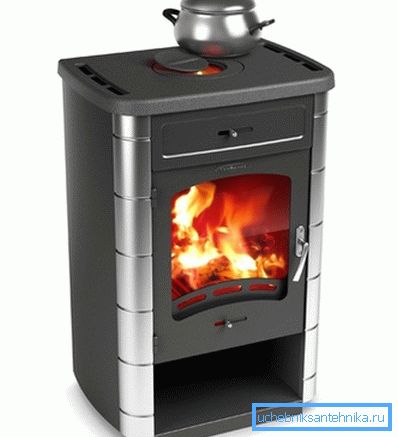
Gas Generating Furnaces
Device and principle of operation
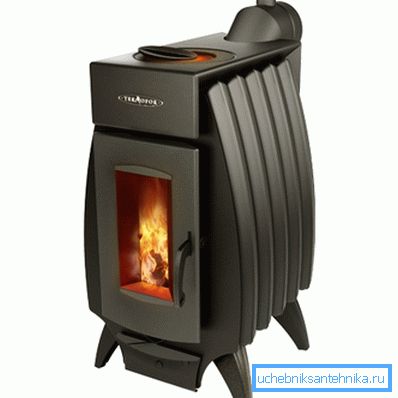
The principle of pyrolysis is the basis of the operation of a long-burning furnace - thermal decomposition of the fuel into components. When wood is heated to a temperature of about 500 degrees, hydrogen, methane, acetone, furan, aldehydes, methyl alcohol and other volatile compounds are released from it (see also the article Heating and Cooking Long-Burning Furnaces: Design Features and Purpose).

These substances enter the afterburner chamber, where they are mixed with fresh air and burned. In normal combustion, most of these compounds fly away with smoke, since there is not enough oxygen to burn them.
As a result of pyrolysis, it is possible to achieve a significant increase in the efficiency of such devices, increase the burning time of firewood and reduce fuel consumption.
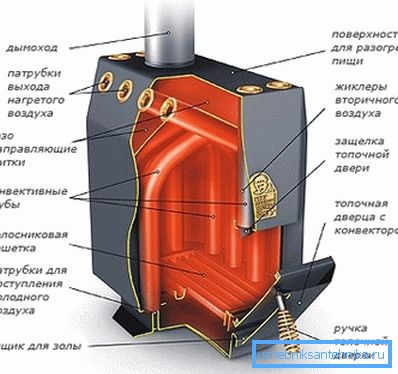
A simple model consists of the following parts:
- Roomy refractory steel or cast iron firebox;
- Grate;
- Ash box;
- Convection pipes around the firebox;
- Secondary air nozzles for the afterburning of pyrolysis gases;
- Fire door;
- Gas guards;
- Chimney;
- Cooktop.
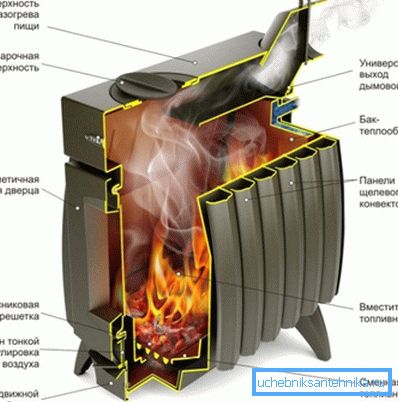
After laying the wood in the furnace begins their usual burning. In this mode, the unit generates a large amount of heat and quickly warms the room in about 25 - 30 minutes. Then the furnace is put into smoldering mode by switching the dampers, and the process of pyrolysis combustion begins.
Through the nozzles, fresh air enters the upper parts of the common firebox, and the decay products of wood begin to burn. The heat generated is sufficient to maintain the temperature in an already heated room, while the firewood burns much slower due to oxygen deficiency, providing significant savings.
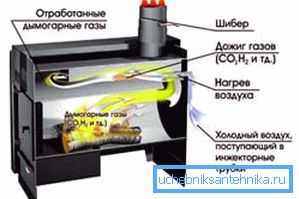
Along the outer walls of the unit are convection channels through which air circulates due to natural thrust. Such circulation allows to warm the room efficiently, in addition, the exhaust heat does not allow the body to overheat to dangerous temperatures.

Note! The high-quality models are equipped with a cast-iron grate, protection against burning out of the firebox and a large combustion chamber with a convenient door. But the main difference of a high-quality product is the welding seams that are missing inside the firebox, because under the conditions of burning coals they quickly burn through.
Advantages and disadvantages
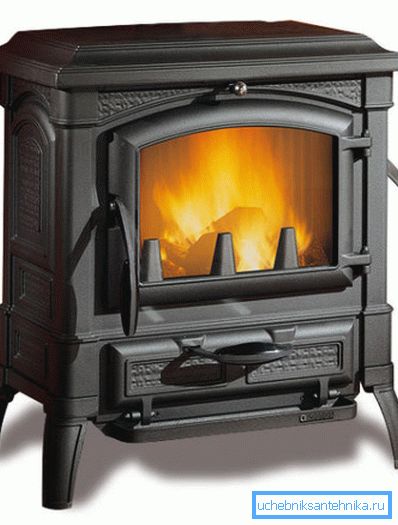
Gas-generating stoves proved to be an excellent alternative to boilers and fireplaces, they are able to heat a room ranging from 80 to 250 m2, depending on the size and device. This property is especially important for a country house or a country house, in which you are occasionally.
Consider the main advantages of devices of this class:
- Due to the rational combustion mode, there is a noticeable fuel economy;
- The efficiency reaches a record 85% for devices of this class;
- The dimensions of the unit can be very compact, which allows you to choose the model that best fits your room;
- The burning time of one bookmark of firewood reaches 5 to 8 hours, and in some designs and all 10. This allows you to sleep at night in a warm room;
- Simple control. Switching of the modes of burning / smoldering occurs by adjusting the air supply flaps;
- The ability to burn any dry biomass: firewood, wood chips, sawdust, straw, pellets, briquettes, etc .;
- Relatively low price: from 10 - 15 thousand rubles.
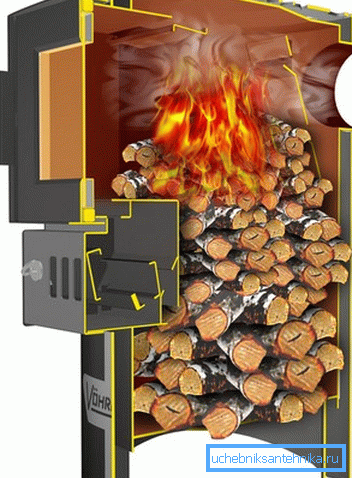
Disadvantages are also available:
- High requirements for the installation of the chimney due to the high temperature of the smoke and a large amount of condensate;
- High content of tar and other products of combustion, from which it is often necessary to clean the chimney;
- Work on only one type of fuel - solid or liquid;
- A heating furnace of long-term burning is done very hard with your own hands; experience of a welder, a locksmith, a killer and other rare skills is needed here.
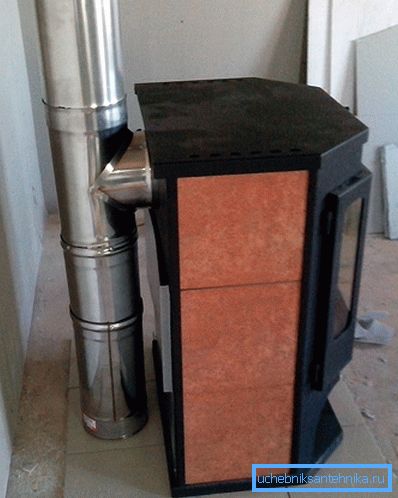
Note! First of all, you must decide whether you can put up with the shortcomings of the device, and only then anticipate its advantages. This equipment requires timely maintenance and proper installation, especially for the chimney.
Water heating
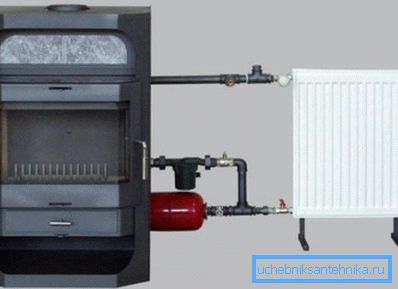
It is necessary to mention the possibility of using a gas generator for heating the heating medium of the heating system. For these purposes, the design of the device is complemented by a heat exchange capacity into which water enters.
In this tank, the water is heated and begins to circulate around the heating circuit through natural circulation or by means of a pump. This scheme is quite suitable for heating small houses.
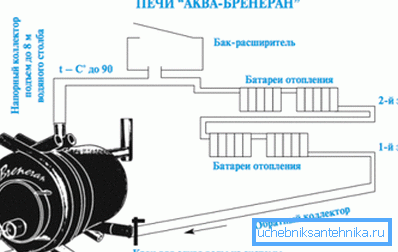
For heating larger areas use pyrolysis boilers, the power of which is much greater. In addition, they differ in the design and organization of the movement of air and smoke masses.
The system is supplied with an open or membrane expansion tank depending on the type of heat carrier used and the selected heating scheme. The instruction here does not impose strict requirements.
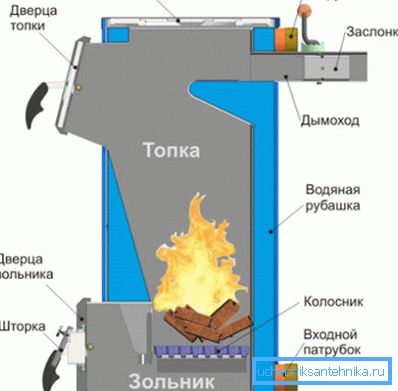
Note! The most modern and advanced models allow you to automate the process up to the automatic feeding of fuel cells using a screw.
Conclusion
Long burning stoves allow you to organize the heating of a small country house for relatively little money. At the same time, the device is distinguished by high efficiency and significant fuel savings (see also the article Wood-burning stoves: traditional and modern devices for heating a home).
The video at the end of the article demonstrates the features of the work of the aggregates of this class.